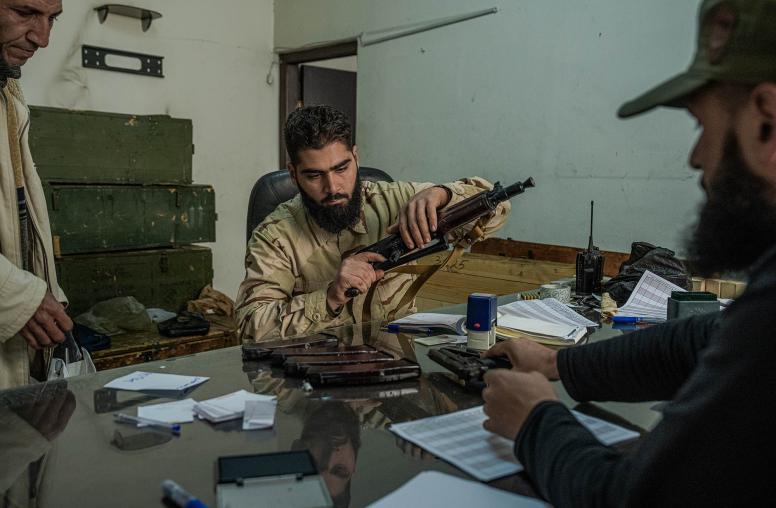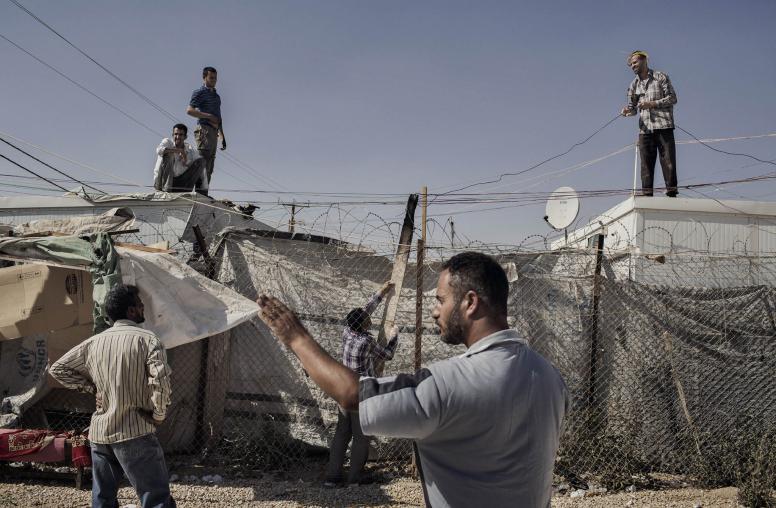New U.N. Goals Highlight Danger of 'State Fragility' to Development
A new set of development goals that will be adopted by the world’s heads of state at the United Nations in September highlights the crucial problem of “fragile states” and the need to strengthen their governance, according to experts including current and former top diplomats and USIP President Nancy Lindborg.
Former U.K. Foreign Secretary David Miliband and U.S. Assistant Secretary of State Linda Thomas-Greenfield discussed fragility and its role in the new U.N. “Sustainable Development Goals” alongside Lindborg and Elizabeth Cousens, deputy CEO of the United Nations Foundation in a June 3 forum at USIP. The set of 17 targets for the international community to pursue in the next 15 years will replace eight “Millennium Development Goals” that were adopted in 2000 and were to be reached this year.
“The danger is … frustration that, at a time of greater resources to make more of a difference, we’re not making more of a difference.” – Former U.K. Foreign Secretary David Miliband
Increasingly, fragile states -- those that lack effective or legitimate systems of government -- have become the world's main focal points of violent conflict and extreme poverty, often undermining decades of development efforts and billions of dollars of investment. The concepts of fragility and, conversely, resilience, began to emerge in academic discourse two decades ago. Now, countries such as Sierra Leone, Timor Leste, Guatemala and Nigeria that have struggled with state fragility have pushed for recognition of how such problems impact the sustainability of development initiatives.
The U.N. General Assembly plans to approve the new Sustainable Development Goals at its September session. The draft includes a call to build resilient states with “peaceful and inclusive societies, access to justice for all, and effective and capable institutions.” The Millennium Development Goals focused almost entirely on issues such as poverty, education and health.
The change represents a profound shift among the world's biggest development agencies, said Lindborg. She described fragile states as countries where governance is generally “weak and ineffective, and also illegitimate in the eyes of its citizens.”
Fragile states are significant not only because of their inability to provide for their own citizens, but because their crises can spill into neighboring countries, said Lindborg and Miliband, who now serves as the CEO of the International Rescue Committee. Both cited Syria, which was a middle-income country before it plunged into war in 2011. Now, Lindborg said, Syria has lost 60 years of development gains in five years of conflict. The civil war has forced millions of its citizens to flee into Lebanon, Jordan and Turkey, which are unable to provide both for these refugees and for their own citizens, said Miliband.
The Organization for Economic Cooperation and Development has helped frame the discussion of fragility, defining a fragile state as one “unable to meet [its] population's expectations or [to] manage changes in expectations and capacity through the political process.”
What 'Fragility' Looks Like
Fragile states are often characterized by a lack of infrastructure and development, noted Thomas-Greenfield.
“Of the top 10 most fragile states in the world, six [South Sudan, Somalia, Central African Republic, Democratic Republic of the Congo, Sudan, and Chad] are in Africa,” she said.
Miliband emphasized that weak governance often leaves fragile states “consumed by internal violence.” A government's job is to meet basic needs -- for security, the rule of law and economic opportunity -- and ensure that a country can withstand external shocks, he said. In fragile states those tasks are unfulfilled.
“For the last 20-plus years, our development paradigms [have been] focused on investing in [economic] growth,” said Lindborg. But in fragile countries -- where systems of governance are made ineffective because they are not inclusive of the population -- “investment [is] flushed away because the state is not strong enough to manage conflict or withstand natural disaster.”
Experts often describe resilience -- a country's ability to withstand economic, political or other shocks—as the opposite of fragility. But Cousens cautioned against seeing a simple dichotomy of “fragile” and “resilient” states. In truth, she said, countries are ranged on a spectrum, with some relatively fragile states, such as Rwanda and Ethiopia, still able to overcome deep conflict.
Thomas-Greenfield urged greater attention to countries that may not be fragile, but are “one step, five steps above fragile,” so that they do not “fall down.” By looking more broadly at U.S. assistance, she said, the United States can help avoid setbacks among countries that are moving forward. Cousens, a former ambassador who led U.S. negotiations on the Post-2015 Development Agenda between 2009 and 2012, noted a “paucity of data” and a lack of agreement on measurements of fragility, such as statistics. She called for uniformity among definitions and data to permit better understanding of the vulnerabilities that underpin state fragility.
Sustainable Development Goals
Among the United Nations' draft Sustainable Development Goals, Goal 16 makes the appeal for building resilient states. The draft urges an expansion of “inclusive, participatory and representative decision-making at all levels.” It calls for developing “effective, accountable and transparent institutions,” and ensuring “responsive, inclusive, participatory and representative decision-making.”
The SDGs were drafted through an open working group of the U.N. General Assembly, with input from member states and civil society groups. Miliband expressed concerns that the goals may be too expansive. Compared with the eight objectives outlined in the Millennium Development Goals, the follow-on document more than doubles the number of aims.
“The scale of 17 goals and 169 targets—even for advanced countries, this is challenging,” Miliband said. “So with fragile institutions, I fear that the infrastructure and bureaucracy running it … it will be tough.”
To criticism about a lack of exact targets in the SDGs, Cousens said the goals should be viewed as a framework, and their implementation can be dealt with separately. Establishing a target does not assure implementation, but rather poses it as a sort of follow-up question, she said. “It's what you do next.” Cousens and Lindborg also lauded Goal 5, which calls for the world to “attain gender equality [and] empower women and girls everywhere.” The gender goal includes eliminating gender-based violence and discrimination, assuring full participation and leadership by women across public and private sectors, and guaranteeing access for women to resources, and to sexual and reproductive rights.
Optimism for 'Fragile' States
While the panelists noted the growing complexity of development challenges, all were optimistic on the future of fragile states. Thomas-Greenfield cited the recent elections in Nigeria as an inspiration. In a country with 120,000 polling stations that were too far flung for international monitors to visit, she said, Nigerian volunteers ensured the election's success—a democratic first for the country in its peaceful transition from one elected political coalition to another.
Cousens highlighted the daily bravery and extraordinary commitment of people she has met overseas, from communities to peacekeepers and aid workers.
“Seeing how people don't just endure, but continue to find joy in the midst of crisis … [is] really humbling and inspiring,” added Lindborg. “The resources for making a difference are greater than ever before,” said Miliband. “So the danger is … frustration that, at a time of greater resources to make more of a difference, we're not making more of a difference. I think that's what inspires people to action and always has, across the ages.”
Aparna Ramanan is a senior program assistant in USIP's Center for Applied Research on Conflict.


